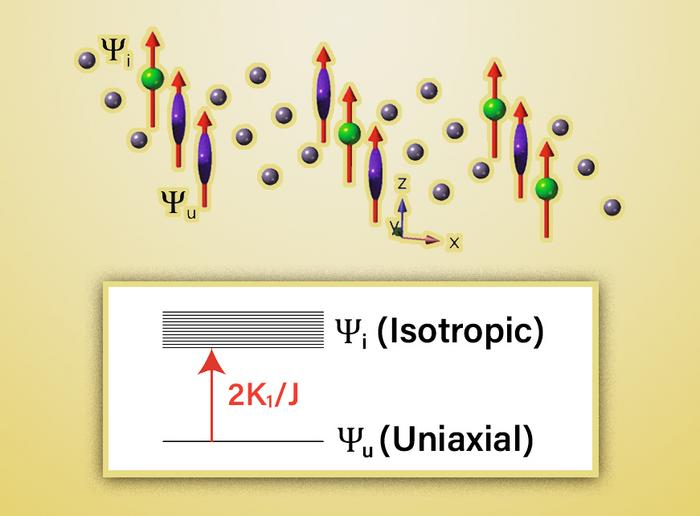A team from Ames National Laboratory conducted an in-depth investigation of the magnetism of TbMn6Sn6, a Kagome layered topological magnet. They were surprised to find that the magnetic spin reorientation in TbMn6Sn6 occurs by generating increasing numbers of magnetically isotropic ions as the temperature increases.

Credit: U.S. Department of Energy Ames National Laboratory
A team from Ames National Laboratory conducted an in-depth investigation of the magnetism of TbMn6Sn6, a Kagome layered topological magnet. They were surprised to find that the magnetic spin reorientation in TbMn6Sn6 occurs by generating increasing numbers of magnetically isotropic ions as the temperature increases.
Rob McQueeney, a scientist at Ames Lab and project lead, explained that TbMn6Sn6has two different magnetic ions in the material, terbium and manganese. The direction of the manganese moments controls the topological state, “But it’s the terbium moment that determines the direction that the manganese points,” he said. “The idea is, you have these two magnetic species and it is the combination of their interactions which controls the direction of the moment.”
In this layered material, there is a magnetic phase transition that occurs as the temperature increases. During this phase transition, the magnetic moments switch from pointing perpendicular to the Kagome layer, or uniaxial, to pointing within the layer, or planar. This transition is called a spin reorientation.
McQueeney explained that in Kagome metals, the spin direction controls the properties of topological or Dirac electrons. Dirac electrons occur where the magnetic bands touch at one point. However, magnetic order causes gapping at the points where the bands are touching. This gapping stabilizes the topological Chern insulator state. “So you can go from a Dirac semimetal to a Chern insulator just by turning the direction of the moment,” he said.
As part of their TbMn6Sn6 investigation, the team performed inelastic neutron scattering experiments at the Spallation Neutron Source to understand how the magnetic interactions in the material drive the spin reorientation transition. McQueeney said that the terbium wants to be uniaxial at low temperatures, while the manganese is planar, so they are at odds.
According to McQueeney, the behavior at very low or very high temperatures is as expected. At low temperatures, the terbium is uniaxial (with electronic orbitals shaped like an ellipsoid). At high temperatures, the terbium is magnetically isotropic (with a spherical orbital shape), which allows the planar Mn to determine the overall moment direction. The team assumed that each terbium orbital would gradually deform from ellipsoidal to spherical. Instead, they found both types of terbium exist at intermediate temperatures, however the population of spherical terbium increases as the temperature increases.
“So, what we did was we determined how the magnetic excitations evolve from this uniaxial state into this easy plane state as a function of temperature. And the long-standing assumption of how it happens is correct,” said McQueeney. “But the nuance is that you can’t treat every terbium as being exactly the same on some timescale. Every terbium site can exist in two quantum states, uniaxial or isotropic, and if I look at a site, it’s either in one state or the other at some instant time. The probability that it’s uniaxial or isotropic depends on temperature.” We call this an orbital binary quantum alloy.
This research is further discussed in “Orbital character of the spin-reorientation transition in TbMn6Sn6,” written by S.X.M. Riberolles, Tyler J. Slade, R.L. Dally, P.M. Sarte, Bing Li, Tianxiong Han, H. Lane, C. Stock, H. Bhandari, N.J. Ghimire, D.L. Abernathy, P.C. Canfield, J.W. Lynn, B.G. Ueland, and R.J. McQueeney, and published in nature communications.
Ames National Laboratory is a U.S. Department of Energy Office of Science National Laboratory operated by Iowa State University. Ames Laboratory creates innovative materials, technologies, and energy solutions. We use our expertise, unique capabilities, and interdisciplinary collaborations to solve global problems.
Ames Laboratory is supported by the Office of Science of the U.S. Department of Energy. The Office of Science is the single largest supporter of basic research in the physical sciences in the United States and is working to address some of the most pressing challenges of our time. For more information, please visit https://energy.gov/science.
Journal
Nature Communications
DOI
10.1038/s41467-023-38174-5
Article Title
Orbital character of the spin-reorientation transition in TbMn6Sn6
Article Publication Date
9-May-2023




